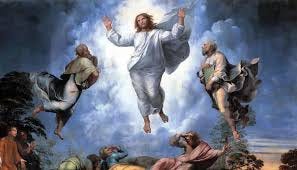The Transfiguration of the Lord
Gospel Reflection for Wednesday August 6th, 2025, The Feast of the Transfiguration
Today we celebrate the Transfiguration of the Lord. This event is momentous in the lives of the Apostles: Peter, James, and John. Our Lord brings these three, His inner circle, to the top of Mt. Tabor and reveals His divinity to them.
I want to connect this event to what the Synoptic Gospels tell us falls roughly six days prior, and that is the Confession of St. Peter. In particular, in the Gospel according to St. Matthew, we hear that Our Lord asks His apostles who they say that He is. St. Peter, inspired by God and enlightened to this divine truth, speaks for the rest:
“You are the Christ, the Son of the Living God.” Matthew 16:16.
This is a revelation of the divine identity of Jesus Christ. Our Lord then affirms to Peter and the rest that flesh and blood had not revealed this. Peter did not gather this information from what Jesus had said or done. This particular revelation was given to Peter by the Father, who is in heaven.
Now, why is this important? It is because there is an inseparable connection between the confession of the divine identity of Christ by St. Peter and the visible manifestation of that divine identity on the Mount of the Transfiguration, and these two events correspond to the two Jewish feasts: Yom Kippur, the Day of Atonement, and Sukkoth, the Feast of Tabernacles.
The Day of Atonement is a sacred day when the High Priest would utter the name of God in the Holy of Holies, the only time this would happen. Pope Benedict XVI writes:
“This would mean that Peter’s confession fell on the great Day of Atonement and should be interpreted theologically against the backdrop of this feast, on which, for the one time in the year, the high priest solemnly pronounced the name YHWH in the Temple’s Holy of Holies.”1
Pope Benedict correctly connects the utterance of St. Peter, the Vicar of Christ, to the utterance of the High Priest speaking the name of God. A name communicates identity, and St. Peter uses the proper name of the Second Person of the Trinity to identify the Lord. He is Son of the Living God. No other person can claim this identity, and Peter, under the inspiration of God, utters this holy name. While the high priest is uttering YHWH, St. Peter is uttering the divine identity become incarnate.
Six days afterward, the weeklong Feast of Tabernacles, also called Feast of Tents, occurs. It is during this weeklong feast, the synoptics all attest, that the Transfiguration happens:
“Jesus took Peter, John, and James and went up a mountain to pray. While he was praying, his face changed in appearance and his clothing became dazzling white. And behold, two men were conversing with him, Moses and Elijah, who appeared in glory and spoke of his exodus that he was going to accomplish in Jerusalem.” Luke 9:28-29
This change in appearance is the manifestation of the confession of St. Peter. Where flesh and blood did not reveal at his confession, here, these apostles are given a visible affirmation of their faith in Jesus Christ. What significance, then, does the Feast of Tents have? We want to remember that for the Apostles, and any Jewish person at the time, the Jewish liturgical calendar was at the center of their lives. They lived life by it and saw the world through it. This gives context to the next lines of today’s Gospel:
“Peter and his companions had been overcome by sleep, but becoming fully awake, they saw his glory and the two men standing with him. As they were about to part from him, Peter said to Jesus, “Master, it is good that we are here; let us make three tents, one for you, one for Moses, and one for Elijah.” Luke 9:32-33
Knowing what time of year it was, and understanding the weight of this event, Peter appeals to the Feast and offers to build Tents for Our Lord, Moses, and Elijah. For the Jews, the Festival of Tents remembers when Moses goes outside of the camp and builds the Tent of Meeting, and God comes down to dwell with the Israelites (Thus the term Tabernacle is used). Peter recognizes two things about the Transfiguration:
God has come to dwell with mankind.2 The Transfigured Christ has confirmed Peter’s confession and has revealed His glory in a much greater way than the Pillar of Cloud in Exodus with Moses.
The Messianic Age has truly begun. The presence of Moses and Elijah as the representatives of the Law and Prophets confirms Christ as the Messiah. It should not be lost on us that they speak of Christ’s exodus, that is, His Paschal Mystery.
Our Lord is not ignorant of these connections to the Jewish Calendar. Remember, all that came before in the Old Testament under the Old Law is a precursor and preparation for the New. Likewise, these Jewish feasts are preparations for the coming of Christ, and it is in Him that they are completed and perfected.
Pope Benedict XVI, Jesus of Nazareth, 306.
Cf. John 1:14.



As always you clarify our faith and teachings so well. You also connect the OT and NT so well showing it to be a seamless cloth!
Beautiful posts for a beautiful day.